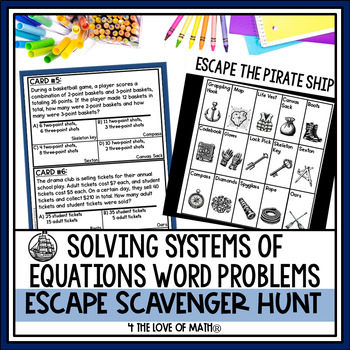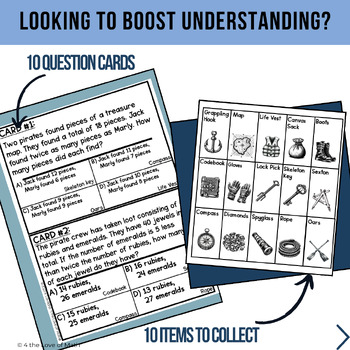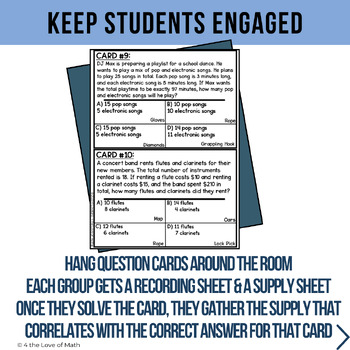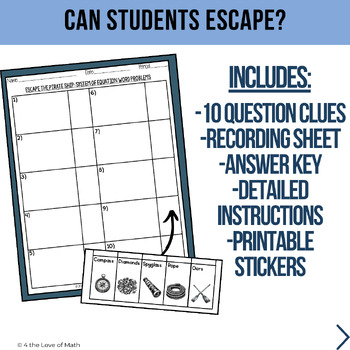Solving Systems of Equations Word Problems Activity: Escape the Pirate Ship
Description
Embark on a thrilling maritime quest with the Escape the Pirate Ship Systems of Equation Word Problems Scavenger Hunt Activity. This solving systems of equations word problems immersive activity, turns the classroom into a vessel of mystery and discovery! Crafted for the bold and inquisitive spirits of students, this distinctive challenge begins with a compelling narrative: students find themselves marooned on a mysterious pirate ship. Yet, all is not lost! 10 critical items are hidden throughout the ship. Solve 10 systems of equations word problems to uncover the items. But beware—the ship is laden with decoy tools designed to mislead and test the problem-solving mettle of each student.
As students delve into the problems, they'll find each correct answer yields a printable picture of a resource they need, which they can then attach to their recording sheets. This tangible element not only brings the solving systems of equations word problems activity to life but also simplifies the grading process - instead of needing to read each written answer, teachers can instead check that the correct tools are attached to the sheet.
This Solving Systems of Equations Word Problems Activity Includes:
- 1 Background Card: Setting the scene with a detailed scenario.
- 10 Engaging Clue Cards: Each card holds a system of equation word problem question that leads students towards finding to a tool they need to escape.
- Tool cards: These cards print so there are 2 sets per page. Each group needs 1 set of tool cards.
- Recording Sheet: Recording sheet has space for students to show their work, along with space for them to glue tool cards to.
- Answer Keys: For easy facilitation.
- Bonus - Printable page of patches: that can be printed on sticker paper and given to students who successfully 'escape' the pirate ship.
The question cards are designed to be placed around the classroom, turning the lesson into a fun scavenger hunt, fostering collaboration, critical thinking, and lively discussions.
Ideas for Implementation of this Solving Systems of Equations Activity:
- Collaborative Small Groups: Foster teamwork and discussion by having students work in small groups, solving equations and piecing the mystery together.
- Whole Class Engagement: Transform your classroom into a bustling hub of activity, with students moving, discussing, and solving as a united class.
- Interactive Review Sessions: Utilize this activity as a dynamic and enjoyable review session, ensuring readiness for upcoming tests on multi-step equations.
Check out these other "Escape the Space" Adventures:
Writing Linear Equations from a Table: Escape the Enchanted Forest
Adding & Subtracting Polynomials: Escape the Alien Spaceship
Simple Prep:
Print and Go: Preparation is a breeze – simply print the necessary pages, cut the clue cards, hang them around, and you’re ready to dive into the mystery!
If you have any questions, please email me: randi@4theloveofmath.com
Thank you!





